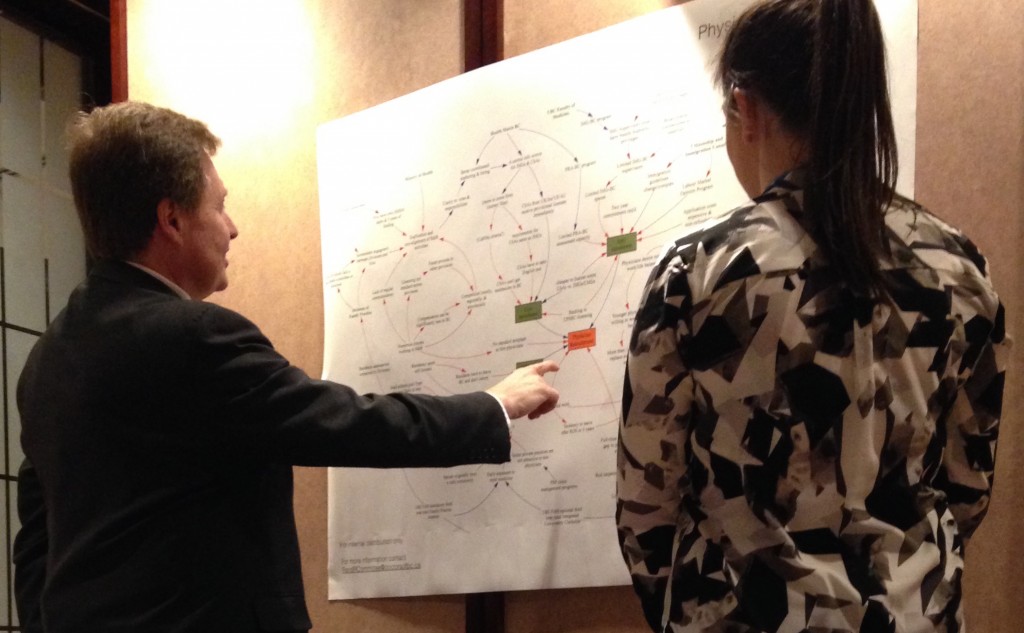Hello! I’m Kylie Hutchinson (a.k.a. @EvaluationMaven), independent evaluation consultant with Community Solutions Planning & Evaluation and volunteer member of the 2016 Systems in Evaluation (Un)Conference coordinating committee.
The day I completed my first real system map felt like a real accomplishment. A system map visually depicts the various elements present in a given system and identifies opportunities to intervene. I put a lot of time into developing the map, and thoughtfully expanded it to legal-size paper for improved readability. Then I proudly presented it at my next advisory committee meeting, only to be met with a table of blank stares looking back at me. People were polite, but I heard things like, “It’s…uh…kind of overwhelming.”
I stood there baffled. To me, the potential leverage points and strategies were literally jumping off the page! How could they not get it? Then it dawned on me that not everyone likes to learn through visuals like I do. Put simply, people have different learning preferences. Some prefer visual learning, some prefer auditory, and still others prefer learning kinesthetically by “doing.” Learning preferences is a massive area of study, but suffice to say that if I wanted my stakeholders to understand and use the map, I needed to accommodate these learning preferences in some way.
Hot Tip: For those who aren’t visual learners, consider reformatting your map into an accompanying table, with each element of the map comprising a row in the table. For those with an auditory learning preference, walk them through the map discussing the various elements and connections present. For those who prefer to learn kinesthetically, provide them with an opportunity to physically develop the map themselves in a group using post-it notes, crayons, and mural paper, or thumbtacks and string or rubber bands.
Hot Tip: Print out your map as an 11 x 17 (A3) data placemat and bring copies to every meeting. This encourages stakeholders to not ignore the map and gives them additional opportunities to review it, doodle on it, and use it. Or print it out as a 36” x 48” poster and hang it in the lunch room with a pencil.
Lesson Learned: I am now convinced that systems maps and flow charts are primarily helpful for one group of people only – those that actually created them. So involve as many users as you can in their hands-on development. Then people can see for themselves why one element or arrow in the map might influence another.
Rad Resource: To draw my systems map I used VensimPLE software. With only a short video tutorial I was up and running with the basics.
Rad Resource: You can also find resources for developing systems maps on this Pinterest page.
The American Evaluation Association is celebrating this week with our colleagues in the Systems in Evaluation Topical Interest Group. The contributions all this week to aea365 come from our Systems in Evaluation TIG members. Do you have questions, concerns, kudos, or content to extend this aea365 contribution? Please add them in the comments section for this post on the aea365 webpage so that we may enrich our community of practice. Would you like to submit an aea365 Tip? Please send a note of interest to aea365@eval.org. aea365 is sponsored by the American Evaluation Association and provides a Tip-a-Day by and for evaluators.


Hi Kylie,
I found your blog very relatable as I have often prepared what I thought was a stellar presentation and was met with more than a few blank stares around the room.
The question I have for you revolves around giving feedback during a program or case evaluation. While making a connection with the clients is so vital to having them on board and working towards program use, how would you suggest going about creating feedback and ways to deliver information that will keep everyone engaged and learning at the same pace?
As a teacher I find I am faced with this everyday, however I feel that working within program evaluations and working with adults allows less room for error and a smaller chance of forgiveness and a chance to go back and deliver the information in a different way.
Thank you so much for sharing your thoughts and for your time,
Sam